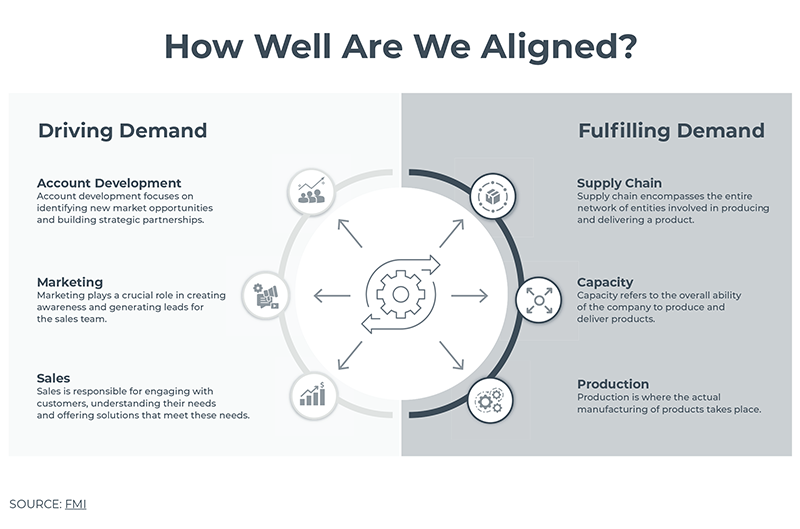Why Internal Alignment Is Key for Building Products Manufacturers

In today’s marketplace, building product manufacturers face the ongoing challenge of maintaining a competitive edge while meeting evolving market demands.
One of the most critical factors influencing their success is the alignment between the teams focused on driving demand (account development, marketing and sales) and those responsible for fulfilling demand (supply chain, capacity and production). This article explores the importance of alignment both internally and externally to achieve success, the challenges posed by misalignment, and strategies for ensuring all departments work cohesively toward shared goals — ultimately enabling companies to capture market share and maintain a competitive advantage.
Establishing alignment within an organization, particularly between driving demand and fulfilling it, is vital in maintaining market position and seizing new opportunities. When these components are coordinated, an organization can more effectively position its products, deliver on customer promises and adapt to market shifts, whether regarding new product types, changing material demands or customer requirements.
Building product manufacturers operate in a sector in which customer expectations are high and competition is continually evolving. Misalignment between the teams responsible for generating demand and those tasked with filling the orders can lead to significant challenges. For example, a robust sales team might succeed in generating substantial market interest, but without the capacity to produce the products the company risks backorders, customer dissatisfaction and, ultimately, lost sales.
This lack of alignment can lead to missed market opportunities. Companies that are reactive rather than proactive in aligning their operations across departments often fall behind competitors, especially when faced with nontraditional entrants offering innovative products. In the building products sector, for instance, new players have introduced lighter, easier-to-install products that have quickly gained traction among contractors. These products, though potentially more expensive, offer efficiency that traditional products may lack, giving nontraditional competitors a significant advantage.
Driving Demand
Individuals in account development, marketing and sales must work together to build interest and convert that interest into sales. Each of these areas plays a critical role in ensuring an organization is aligned with market opportunities and customer needs.
Account Development: Identifying Opportunities and Building Partnerships
Account development is at the forefront of identifying new market opportunities and building strategic partnerships. By staying up to date on emerging markets, profiling potential customers and creating longterm partnerships with existing clients, the account development team can make sure the company is proactive. This can include expanding into new markets or geographies as well as new products.

Marketing: Expanding Awareness and Generating Leads
Marketing plays a crucial role in spreading awareness of a company’s products and generating leads for the sales team. Effective marketing ensures that potential customers are informed about the features and benefits of a company’s products, helping to drive initial interest and position the company as a leader in its industry. Marketing efforts that are wellaligned with account development and sales ensure a consistent message across all customer touchpoints, reinforcing the company’s brand and facilitating easier conversions.
Sales: Engaging Customers and Meeting Their Needs
Sales teams are responsible for directly engaging with customers, understanding their needs and offering solutions to meet those needs. A wellaligned sales team is equipped with the necessary product knowledge and support from marketing and account development, enabling them to effectively close deals and develop long-term customer relationships. Sales teams that are in sync with their customers’ broader organizational strategies can anticipate customer needs, address potential concerns and provide feedback to other departments, guaranteeing continuous improvement in product offerings and customer satisfaction.
Fulfiling Demand
While driving demand is essential, fulfilling that demand is equally critical. Supply chain, capacity and production are the pillars that support the delivery of products to customers, making sure the sales team’s promises are met without delays or quality issues. This necessitates alignment among the fulfillment teams as well as coordination with those who are working to drum up demand for products.
Supply Chain: The Backbone of Product Delivery
The supply chain encompasses the entire network of entities involved in producing and delivering a product from raw material suppliers to distributors. An efficient and well-managed supply chain meets customers’ expectations regarding product availability and delivery. Alignment in the supply chain ensures that materials are sourced efficiently, costs are managed effectively and products are delivered on time. A wellaligned supply chain can also adapt quickly to changes in demand, minimizing disruptions and generating a steady flow of products to the market.
Capacity: The Ability to Meet Market Demand
Capacity refers to the overall ability of a company to produce and deliver products — using the equipment, labor and other resources necessary to, hopefully, meet production goals. Without sufficient capacity, even the best sales efforts can be undermined by an inability to fulfill orders. Aligning capacity withmarket demand is crucial to ensuring the organization can scale production to meet increased demand without compromising on quality or delivery time. This involves strategic planning and investment in manufacturing capabilities to make sure the company can respond to market opportunities as they arise.
Production: Where Products Are Brought to Life
Effective alignment in production ensures that manufacturing processes are efficient, quality standards are maintained and production schedules are met. A well-aligned production team can quickly adapt to changes in demand, whether that means scaling up to meet increased orders or adjusting processes to incorporate new product features.
The Critical Role of Communication
The teams driving demand and those fulfilling it must maintain effective communication. This communication guarantees that the strategies developed to fuel market interest and generate sales are fully supported by the company’s ability to deliver on those promises. When communication is strong and all teams are aligned, organizations can capture a significant market share, delivering value to customers and gaining a competitive edge.
Well-coordinated strategies ensure that a company’s products marketed and sold are fully supported by the supply chain, capacity and production functions. When the sales team pushes a product in the market, the fulfillment team is ready to meet the resulting increase in sales without delays or quality issues. This seamless coordination allows the company to capitalize on market opportunities swiftly, ensuring that customer expectations are met and satisfaction remains high.
Organizations can also leverage effective communication to be more responsive to changes in market conditions. If the demand team identifies a surge in interest for a particular product or a shift in customer preferences, they can share the insights with the fulfillment team in real time. This allows for quick adjustments in production schedules, capacity allocation and supply chain management, helping the organization meet new demand promptly. By staying agile and responsive, companies can capture additional market share and outpace competitors.
The Risks of Misalignment and Poor Communication
When communication is lacking, an organization faces significant risks to its ability to compete effectively. One of the most common issues resulting from poor communication is the risk of overselling the company’s capacity. If the sales team is aggressively pushing a product without a clear understanding of the production capabilities or supply chain limitations, the company may commit to more than it can deliver. This leads to backorders, delayed deliveries and frustrated customers, who may turn to competitors to meet their needs. Overselling not only damages customer relationships but also tarnishes the company’s reputation, and it can be difficult to regain lost trust and market share.
Misalignment can lead to underselling a product that has strong potential as well. If the fulfillment team invests in developing a new product with superior features but the sales and marketing teams don’t have the necessary information, they might not effectively communicate the product’s value to customers. This can result in an excellent product languishing in the market, failing to reach its sales potential due to a lack of customer awareness. In such cases, the company loses market share that could have easily been won with better alignment and communication.
Strategies and Best Practices
To overcome these challenges, organizations must foster a culture of alignment and collaboration across all departments — an operational best practice. This involves several key strategies:
- Communicate alignment goals. Meeting regularly to make sure all departments are on the same page with regard to the company’s goals and strategies to drive product offerings is key. These meetings should involve representatives from each relevant area, including account development, product management, sales, supply chain and production.
- Incorporate customer insights. Companies should prioritize real-time feedback from customers to inform product development and marketing strategies. This outside-in perspective helps ensure that companies’ products and services offered align with customer needs and market demands.
- Share best practices. Encouraging open communication and sharing of best practices across departments helps break down silos and gives teams information about what’s working well across an organization. For example, product management teams should regularly interact with sales and production teams to better understand capacity constraints and customer feedback and to support marketing collateral and products informed by real-world insights. Additionally, if the organization operates multiple product facilities, sharing best practices on operations and addressing capacity challenges can mitigate potential challenges in the company’s ability to meet demand.
- Ensure resources match demand. Organizations need to dedicate sufficient resources and capacity to meet growing demand. This includes not only having the right supply chain partners, but ensuring that production lines are capable of handling increased output without compromising quality or lead times. This is particularly important when organizations are targeting new product areas or looking to solidify their product position in nascent segments.
- Develop the sales team. Equipping the sales team with technical knowledge and an understanding of the company’s products is essential. This can involve targeted training programs that focus on product features and benefits, helping salespeople better communicate these to potential customers.
Aligning for Competitive Advantage
Leadership plays a critical role in enacting the above strategies and ensuring teams are aligned across an organization. Leaders must build systems and processes to encourage alignment, take proactive steps to maintain it and identify metrics to provide warnings of potential misalignment, providing the necessary support while working always to foster a culture of discipline and collaboration. Leaders should encourage departments to work together toward common goals, as a well-aligned organization is on track to not only meet but also exceed market expectations, securing the organization’s place as a leader in its industry.



